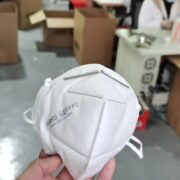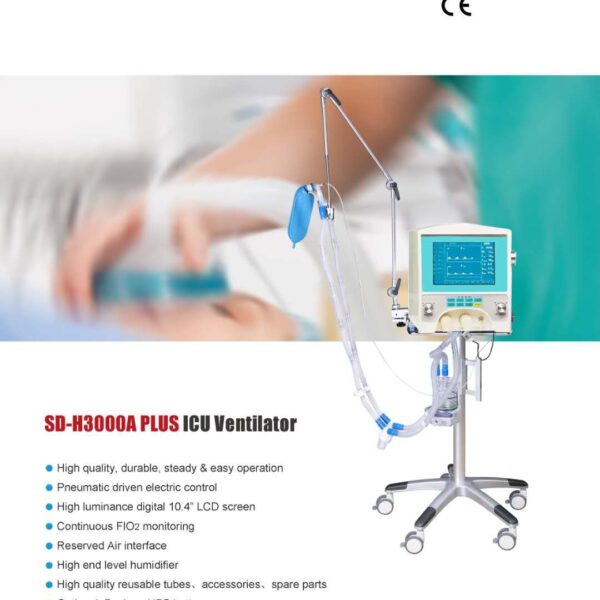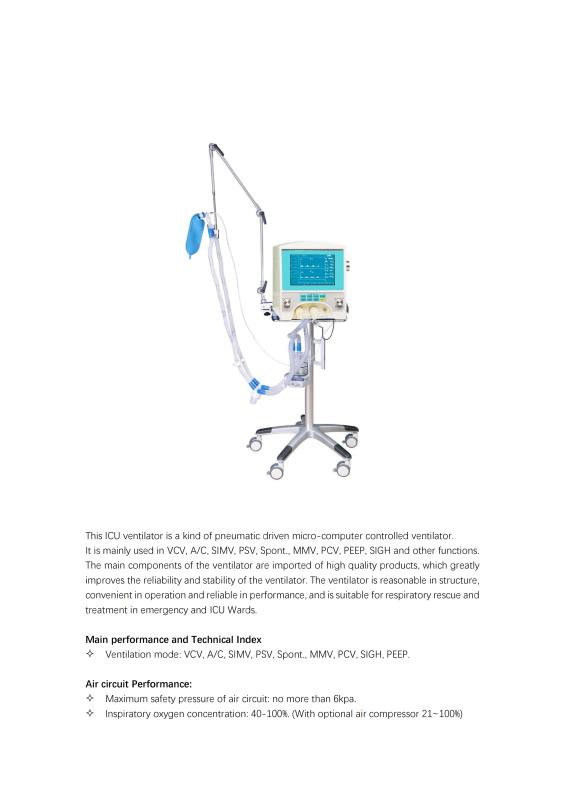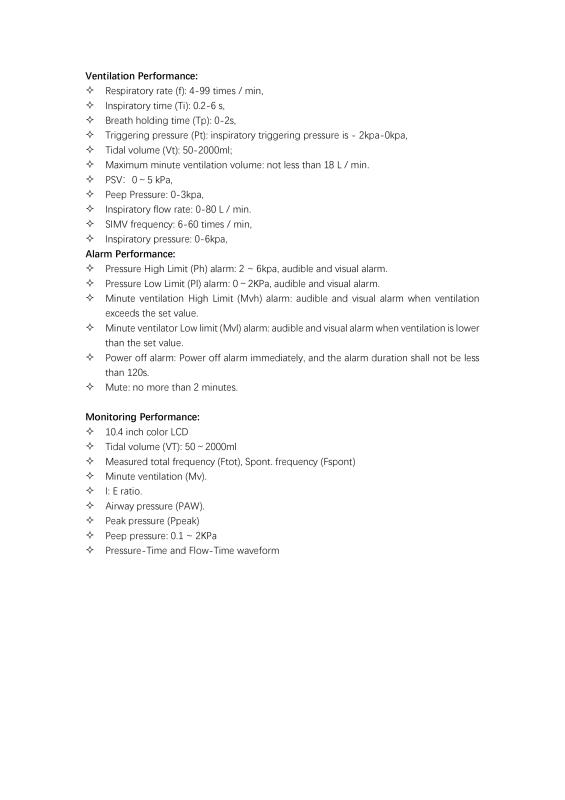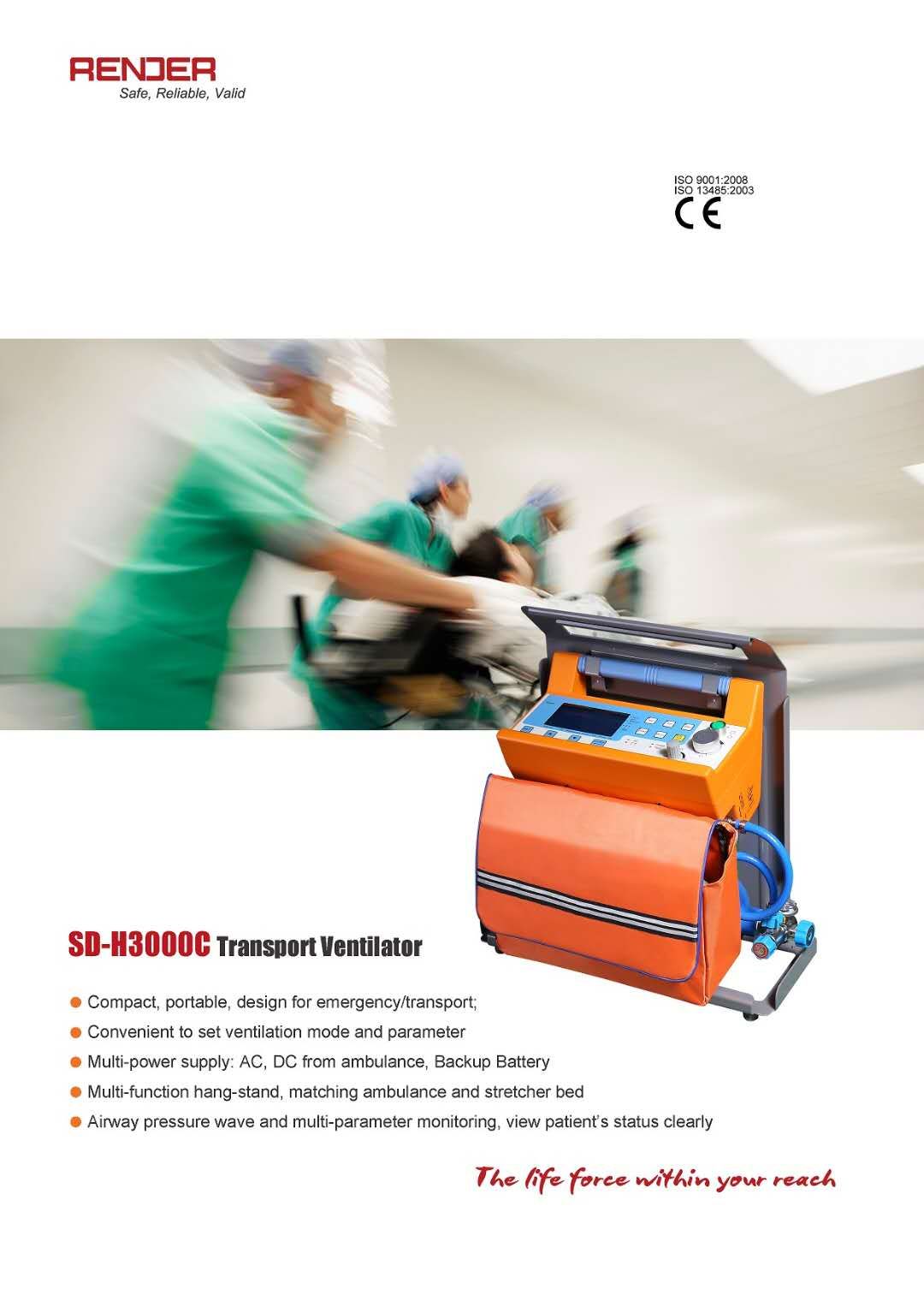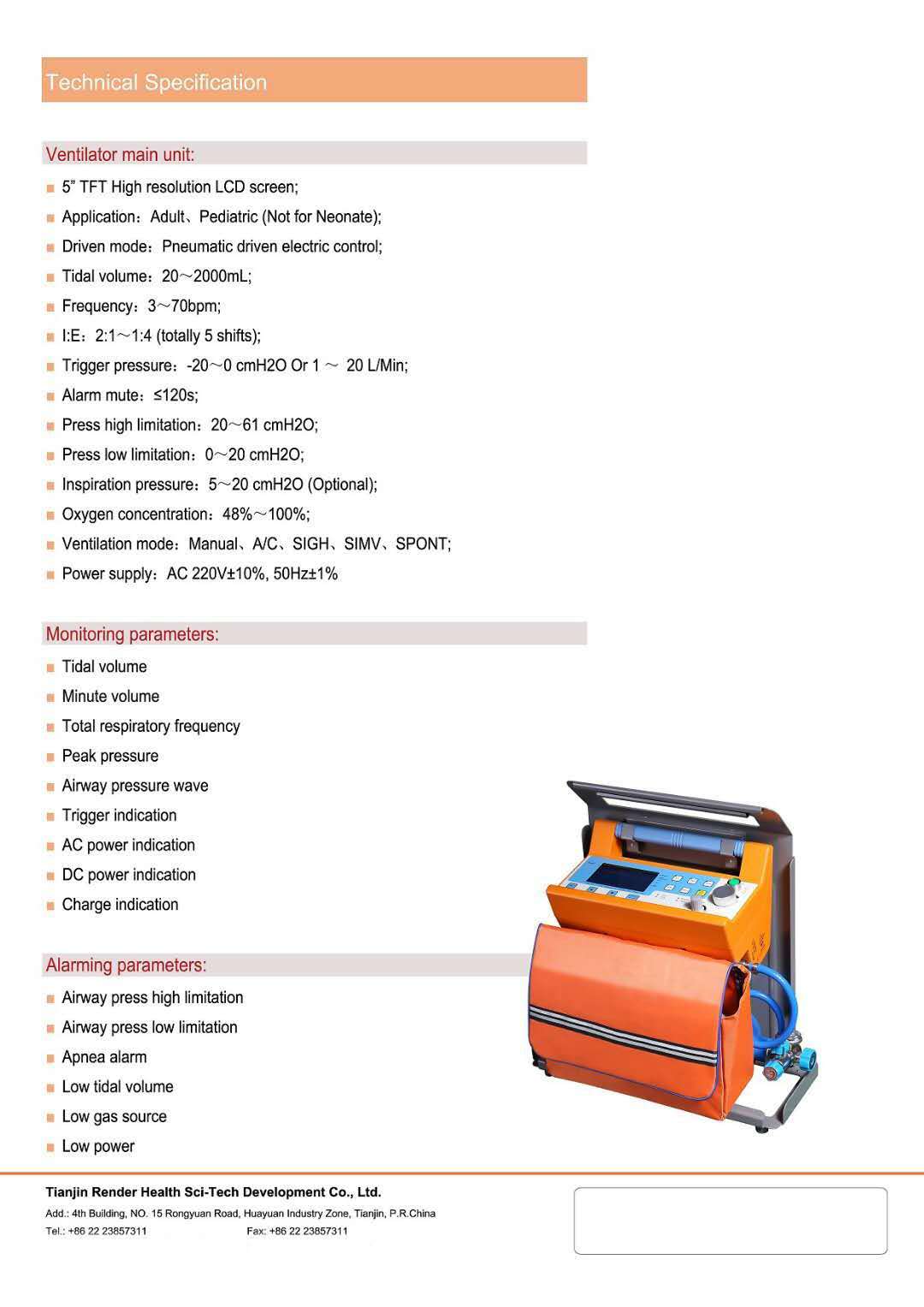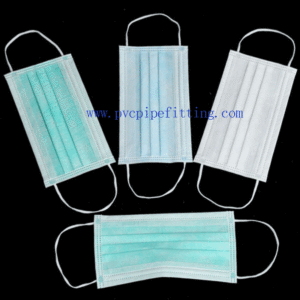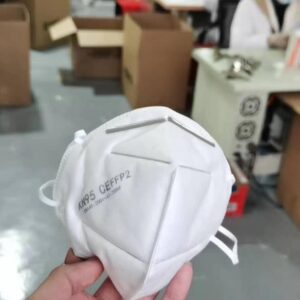The best ventilator supplier
- Description
- Inquiry
ventilator
In modern clinical medicine,ventilator, as an effective means to replace the function of self ventilation, has been widely used in respiratory failure caused by various reasons, anesthesia and respiratory management during major surgery, respiratory support treatment and first-aid resuscitation, and occupies a very important position in the field of modern medicine. Ventilator is a kind of vital medical equipment which can prevent and treat respiratory failure, reduce complications, save and prolong the life of patients.
Classification of ventilator
1、 Classification by type of use or application
(1) Controlled mechanical ventilation (CMV) 1. Definition: when the patient’s spontaneous respiration is weakened or disappeared, it is completely generated, controlled and regulated by the mechanical ventilator. 2. It can be applied to: the disappearance or weakening of autonomic respiration caused by diseases; when the autonomic respiration is irregular or the frequency is too fast, and the mechanical ventilation cannot coordinate with the patient, the autonomic respiration can be inhibited or weakened by artificial methods.
(2) Auxiliary mechanical ventilation (AMV) 1. Definition: in the presence of patient’s respiration, the ventilator assists or enhances the patient’s autonomous respiration. All kinds of mechanical ventilation are mainly triggered by the patient’s inspiratory negative pressure or inspiratory air flow. 2. It is applied to the patients whose spontaneous respiration is regular, but the spontaneous respiration is weakened and the ventilation is insufficient.
2、 Classification according to the use way of mechanical ventilation
(1) Intrathoracic or airway compression type
(2) Pleura
3、 Classification according to the switching mode of suction and expiratory phase
(1) Constant pressure type: when the pressure in the respiratory tract reaches the expected value, the ventilator opens the exhalation valve, and the thorax and lung are passively collapsed or the negative pressure produces the exhalation. When the pressure in the airway keeps decreasing, the ventilator again generates the airflow through the positive pressure, and causes the inhalation.
(2) Constant volume type: send the predicted tidal volume into the lung through positive pressure. When the predicted tidal volume is reached, stop air supply and enter the expiratory state.
(3) Timing type: air supply according to the pre-designed inspiratory and expiratory time. (4) Hybrid (multifunctional).
4、 Air supply according to ventilation frequency
(1) High frequency ventilation: ventilation frequency > 60 times / min. 1. Advantages: low airway pressure, low chest internal pressure, little interference to circulation, no need to seal the airway. 2. Disadvantages: not conducive to the removal of carbon dioxide. 3. Classification: high frequency positive pressure ventilation, high frequency jet ventilation, high frequency oscillation ventilation.
(2) Normal frequency ventilation: ventilation frequency < 60 times / min.
5、 Classification by synchronisation or performance
(1) Synchronous ventilator: the ventilator can be triggered at the beginning of the patient’s self breathing inspiration to supply air to the patient’s respiratory tract and generate inspiration action.
(2) Nonsynchronous ventilator: the negative pressure of the patient’s breath or inhalation can not trigger the supply of air to the ventilator, which is generally only used for patients with controlled mechanical ventilation.
6、 Classification by applicable object
(1) Baby ventilator
(2) Infant ventilator (3) Adult ventilator
7、 Classification by working principle
(1) Simple ventilator
(2) Membranous lung
The mode and function of ventilator
1、 Main mechanical ventilation mode
(1) Interstitial positive pressure ventilation (IPPV): positive pressure in inspiratory phase and zero pressure in expiratory phase. 1. Working principle: the ventilator generates positive pressure in the inspiratory phase, presses the gas into the lung, when the pressure rises to a certain level or the inhaled capacity reaches a certain level, the ventilator stops supplying air, the expiratory valve opens, the patient’s thorax and lung passively collapse, and produces exhalation. 2. Clinical application: all kinds of respiratory failure patients with ventilation function, such as COPD, etc.
(2) Intermittent positive and negative pressure ventilation (ipnpv): positive pressure in inspiratory phase and negative pressure in expiratory phase. 1. Working principle: the ventilator can work in both inspiratory and expiratory phases. 2. Clinical application: negative pressure of expiratory phase can cause alveolar collapse and iatrogenic atelectasis.
(3) Continuous positive airway pressure (CPAP): refers to the patient’s artificial positive airway pressure during the whole respiratory cycle under the condition of autonomous respiration. 1. Working principle: the inspiratory phase is provided with continuous positive pressure air flow, and the expiratory phase is also provided with certain resistance, so that the airway pressure of the inspiratory and expiratory phases is higher than the atmospheric pressure. 2. Advantages: when inhaled, the continuous positive pressure air flow is greater than the inhaled air flow, so that the patient’s inspiratory effort is saved, FRC is increased, and airway and alveolar collapse are prevented. It can be used for exercise before offline. 3. Disadvantages: large disturbance to circulation and large air pressure injury to lung tissue.
(4) IMV and IMV / SIMV 1. IMV: there is no synchronization device, the ventilator supply does not need the patient’s spontaneous breathing trigger, and the time of each supply in the respiratory cycle is not constant. 2. SIMV: it has a synchronous device. The ventilator gives the patient mandatory respiration according to the designed respiratory parameters in each minute. The patient can breathe autonomously without the influence of the ventilator. 3. Advantages: give full play to the ability of self-regulation of respiration in offline; have less influence on circulation and lung than IPPV; reduce the use of seismostatic medicine to a certain extent. 4. Application: it is generally considered to be used when offline. When R < 5 times / min, it still keeps a good oxygenation state. Offline can be considered, and PSV is generally added to avoid respiratory muscle fatigue.
(5) Command ventilation per minute (MMV) 1. When autonomous respiration > preset minute ventilation, the ventilator does not command ventilation, only provides a continuous positive pressure. 2. When the autonomic breathing is less than the preset minute ventilation, the ventilator will give instructions to ventilate and increase the minute ventilation to reach the preset level.
(6) Pressure support ventilation (PSV) 1. Definition: under the premise of autonomous breathing, each inhale receives a certain level of pressure support, increasing the inhaled depth and amount of gas. 2. Working principle: the inspiratory pressure starts with the patient’s inspiratory action and ends with the decrease of inspiratory flow rate to a certain extent or the patient’s efforts to exhale. Compared with IPPV, the support pressure is constant and regulated by the feedback of suction flow rate; compared with SIMV, each suction can be supported by pressure, but the support level can be set according to different needs. 3. Application: SIMV + PSV: used for preparation before taking off line, which can reduce respiratory work and oxygen consumption 4. Indications: exercise ventilator; preparation before taking off line; ventilator weakness caused by various reasons; abnormal respiration caused by severe flail chest. 5. Precautions: generally not used alone, insufficient or excessive ventilation will occur.
(7) Volume support ventilation (VSV): each breath is triggered by the patient’s autonomous respiration. The patient can also breathe without any support, and can reach the expected TV and MV levels. The ventilator will allow the patient to carry out real autonomous respiration, which is also suitable for preparation before offline.
(8) Capacity control of pressure regulation
(9) Working principle: P1 is equivalent to inspiratory pressure, P2 is equivalent to respiratory pressure, T1 is equivalent to inspiratory time, T2 is equivalent to expiratory time. 2. Clinical application: (1) when P1 = inspiratory pressure, T1 = inspiratory time, P2 = 0 or peep, T2 = expiratory time, it is equivalent to IPPV. (2) When P1 = peep, T1 = infinity, P2 = 0, T2 = O, it is equivalent to CPAP. (3) When P1 = inspiratory pressure, T1 = inspiratory time, p2-0 or peep, T2 = desired controlled respiratory cycle, equivalent to SIMV.
2、 Main mechanical ventilation function
(1) At the end of inhalation and before the beginning of exhalation, the ventilator does not supply air, and the exhalation valve continues to close for a period of time to keep the pressure in the lung at a certain level. 2. Clinical application: (1) prolonging the inspiratory time is beneficial to the distribution of gas. (2) It is beneficial to the diffusion of gas (3) it is beneficial to the distribution and diffusion of atomized drugs in the lung (3) it can increase the burden on the heart.
(2) Positive end expiratory pressure ventilation 1. At the end of expiratory, the airway pressure did not drop less than 0, and still maintained a certain level of positive pressure. 2. Clinical application: it is suitable for hypoxemia caused by intrapulmonary shunt, such as ARDS 3. The mechanism of peep to correct ARDS (1) to reduce alveolar collapse and intrapulmonary shunt, correct hypoxemia caused by intrapulmonary shunt (2) to reduce alveolar collapse and increase FRC, which is conducive to the full exchange of gas on both sides of alveolar capillary. (3) The increase of alveoli pressure is beneficial to the diffusion of oxygen to capillaries. The alveoli are always in the state of expansion, which can increase the diffusion area of alveoli. (4) The increase of alveolar inflation can increase lung compliance and reduce respiratory work.
We have ventilator stock,Welcome to consult.
SD-H3000A PLUS ICU VENTILATOR
SD-H3000C TRANSPORT VENTILATOR


